For my 7th trip to the US, unusually I stayed the whole time in a single state, one that I'd only briefly visited the north of three decades previously.
 |
| yes, that's a dog wearing sunglasses |
Florida has the longest coastline in the contiguous United States (2,170 km) and is the only state that borders both the Atlantic Ocean and the Gulf of Mexico. It's very flat (the average elevation is 30 metres), and its highest point is only 105 metres high! It's also the third-most populous state in the US, with about 21 million inhabitants in 2020, despite being only the 22nd in surface area among the 50 states.
 |
| a lifeguard station at Haulover Beach |
We flew in and out of Miami, travelling from Reunion via Mauritius and Dubai, and our first two days were spent in the city, recovering from jetlag. We stayed in the Coconut Grove area, but also visited Coral Gables (a 1920s planned city) and the iconic South Beach. We found most of the vegetation in this part of the state similar to Reunion.
 |
Colony Hotel dates from 1935 and is one of 800 preserved buildings in
South Beach's Art Deco district. Note the "racing stripes" decoration |
 |
Venetian Pool is a beautiful public swimming pool in
Coral Gables embellished with Venetian-style buildings |
 |
| Biltmore Hotel, Coral Gables |
For our drive back to Dunedin (where my brother lives) we chose the scenic route through the Everglades and saw our first alligators in Florida, in Big Cypress National Preserve
 |
| a poisonous Lubber grasshopper |
At his home in Dunedin, my brother has bikes, a kayak, a boat, and even a golf cart so we had to plenty to keep us occupied in the area, especially as the islands and beaches of Honeymoon Island,
Caladesi Island and Clearwater are nearby.
 |
| a sign on Caladesi Island, which is only accessible by boat |
While out cycling, kayaking or on the boat we often saw wildife such as dolphins, birds such as ospreys, manatees and more alligators.
 |
| a manatee approaching the boat |
We visited the nearby town of
Tarpon Springs, home to a large Greek-American community due to the divers who moved there in the 1890s to work in the town's sponge industry.
 |
| A sponge boat at Tarpon Springs docks |
On another day we visited the
Dali Museum in nearby St Petersburg. With over 2,100 works, it has one of the world's most comprehensive Salvador Dali collections.
 |
| View of downtown St Petersburg from the New Pier |
 |
| The Dali museum building is made with 1062 glass panels and is referred to as "The Enigma"
|
 |
| Enchanted Beach with Three Fluid Graces (1938) was my favourite painting of those on display |
 |
| The Disintegration of the Persistence of Memory (1952-1954) |
 |
The museum's staircase is helical with 2¾ rotations (representing Dali's
fascination with the double helix form of DNA) and a continuous handrail |
On another day we went to the city's Fine Art Museum, and Tampa Bay Automobile Museum, which only houses cars in working order, many of them with the keys in the ignition!
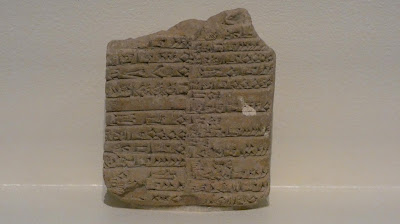 |
| A Bablyonian clay tablet with cuneiform writing from 2100 BC at St Petersburg Fine Art Museum |
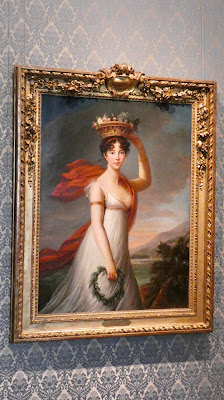 |
1799 painting by Élisabeth Vigée Le Brun of her daugther Julie as Flora,
the goddess of flowers, at St Petersburg Fine Art Museum. |
 |
A 1913 Stearns-Knight (the last known running example of this model)
at Tampa Bay Automobile Museum |
As Dunedin is on Florida's west coast, it was also a good place to watch sunsets.
 |
| watching the sun set over Caladesi Island |
Dunedin, like much of Florida (the US?), is increasingly dog mad and amongst other things we saw dog menus at restaurants on several occasions.
 |
| a dog menu |
 |
| just a dog being driven down Dunedin high street |
 |
when your pet goes to the great dog park in the sky,
you can have them immortalised on this Dunedin wall. |
 |
| stencil seen on pavement in Clearwater |
 |
| in a shopping mall |
Halfway through our visit we took a 4-day trip to the north-east coast, our first stop being the
Kennedy Space Center at
Cape Canaveral.
 |
| looking across Indian River to Kennedy Space Center |
 |
| at Kennedy Space Center |
 |
| Space Shuttle Atlantis at KSC |
The next day we headed up the coast to Daytona, where my husband and brother visited
Daytona Speedway.
 |
| Daytona speedway: 18° at the start line and 31° in the turns |
Our next stop was further up the coast at
St. Augustine, which was founded in 1565 by Spanish explorers, and lays claim to being the oldest continuously inhabited European-established city in the U.S.
 |
| city gates of St Augustine |
 |
| at Castillo de San Marcos |
 |
| view from Castillo de San Marcos |
 |
| at Castillo de San Marcos |
 |
| St Augustine Beach lighthouse dates from the 1870s |
On our way back to Dunedin we stopped at
Blue Springs State Park.
 |
| Thursby House at BSSP, restored to its 1880s' state |
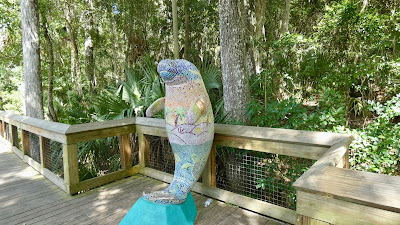 |
| mosaic manatee at BSSP |
Back in Dunedin we did more cycling, kayaking and visiting local sights, including
Anclote Key, where there is a 31-metre tall
lighthouse built in 1887. The island is home to 43 species of nesting birds.
 |
| walking on the beach at Anclote Key |
 |
| at Anclote Key |
 |
| Anclote Key Light |
We spent a day visiting the nearby city of Tampa too, where we rode in a streetcar and ate a
Cuban sandwich: a variation of a ham and cheese sandwich that probably originated in cafes catering to Cuban workers in Tampa and contains salami, pork, pickles and mustard.
 |
| Cuban sandwich in Tampa |
A Spaniard named Ybor moved his cigar business from Key West to Tampa in 1886 and was eventually followed by 20,000 workers from Cuba and Spain, giving rise to Tampa's now-historic "Latin Quarter" called
Ybor City.
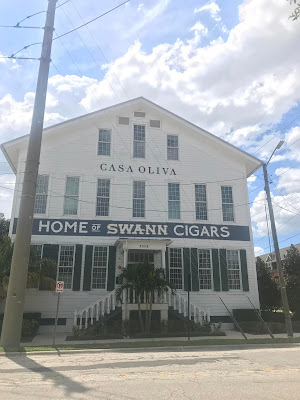 |
| in Ybor City |
As our trip came to an end we had to head back to Miami, but took the opportunity to stop in the Everglades again, this time for an airboat tour.
 |
| airboat in the Everglades |
We didn't seen many alligators on our outing, but we'd already seen plenty elsewhere so weren't too disappointed. At the end, our boat captain showed us a two-year old 'baby' alligator.
We then headed to the Florida keys, where we
dived at Key Largo before driving the 150 km down to Key West for more diving.
 |
| 7-mile bridge on the Florida Keys |
 |
| one of many islands visible from the Florida Keys road |
At Key West we did two
dives on the
Vandenburg, an enormous purposely-sunk former satellite tracking ship that is the second largest artificial reef in the world, and which lies 7 miles south of Key West. In 2017
Hurricane Irma moved it deeper than its original resting position in 2009, and the deepest point of the keel now lies at 50 metres, although the deck is only at a depth of 30 metres or so.
After diving we took the opportunity to visit some of the sights of Key West.
 |
| sharks and tarpon in Key West marina dock |
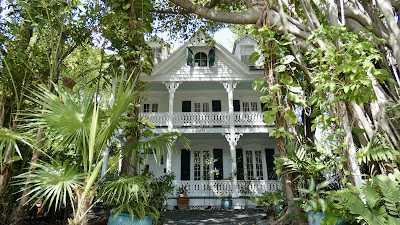 |
| Cosgrove House, built in ≈1850, Key West |
Founded in 1927 by two former U.S. Army Air Corps majors,
Pan Am began as a scheduled airmail and passenger service flying between Key West, Florida, and Havana, Cuba.
 |
| Birthplace of Pan Am airways |
Boat people who emigrated to the US from Cuba, landing in the Florida Keys, were given the name
balseros.
 |
| The Maraina arrived in Key West from Cuba in August 2015 with 24 balseros on board |
 |
| cruise ship at Key West |
 |
| a house in Key West |
 |
| at the southernmost point of the continental US |
All too soon we had to head back up to Miami where we began the long trip back to
Reunion.
See also:





































































